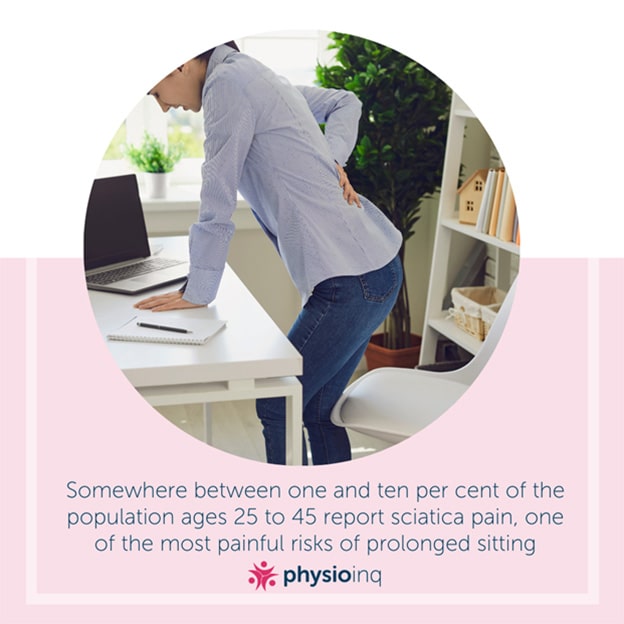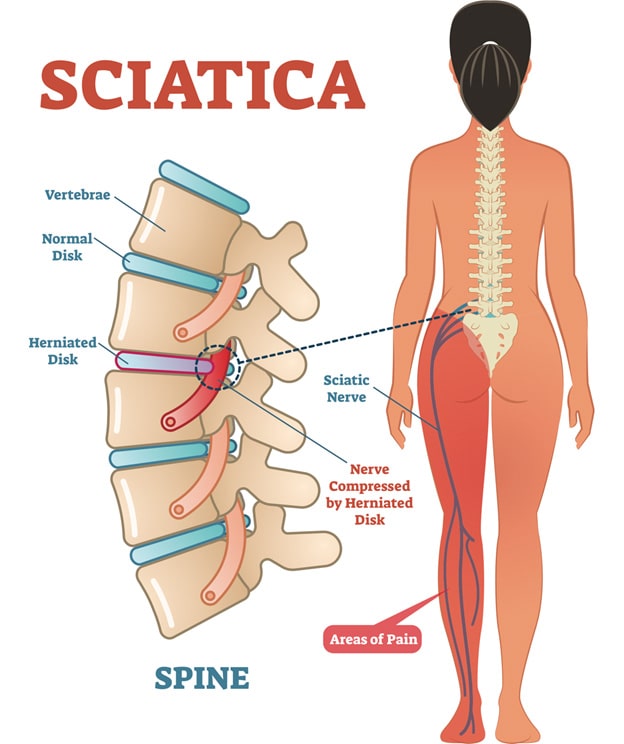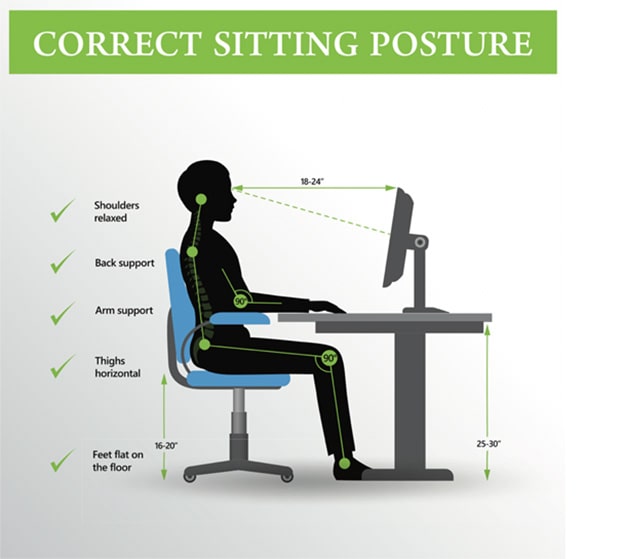Can Prolonged Sitting Cause Sciatica? What You Should Know
Wednesday, May 5, 2021
These days, we might not realise how much we’re sitting down and how this prolonged sitting can have a negative effect on our health.
From sitting on the couch watching Netflix, enjoying long brunches on a Sunday, commuting to and from work on the train and sitting at our desks all day long, we’re sitting a lot.
In this blog post, we’re going over some of the health risks of prolonged sitting, how prolonged sitting affects our bodies, the details of sciatica and some of your most common questions about sciatica and other issues caused by sitting too long.
So, let’s get into it.
Prolonged Sitting Health Risks
Some experts suggest that prolonged sitting is more dangerous than smoking. And while this sounds extreme, sitting for long periods can do damage to our health in ways we might not realise.
As modern lifestyles become more and more sedentary, sitting for long periods of time can cause major issues to your spine. Somewhere between one and ten per cent of the population ages 25 to 45 report sciatica pain, one of the most painful risks of prolonged sitting.
According to a study from National Health and Nutrition Examinations Surveys, 70% of people spend six hours or more sitting down each day. Whether it’s sitting at a desk doing work, sitting to watch TV or sitting in a car, bus or train to commute, many spend most of their waking hours sitting down.
Even those who exercise regularly face health risks from prolonged sitting including:
- Heart disease
- Cancer
- Type 2 diabetes
- Sciatica

Still, regular exercise significantly reduces your risk of these health issues caused by sitting for long periods, but the statistics are unsettling. Essentially, if you sit for any prolonged period, it’s important to be aware of the risks and how to manage them.
Effects of Prolonged Sitting on Muscles
So, why does sitting wreak havoc on our health? Well, sitting has a profound impact on our muscles and spines.
When we sit, all of our upper body weight rests on our lower back. This increased compression in and on our spinal discs and spinal column increases the pressure against our nerve roots that make up our sciatic nerve. This is where sciatica symptoms come in.
Plus, if you have pre-existing back problems, sitting for long periods can worsen your symptoms. Whether it’s additional compression causing problems or it’s that extra irritation to previously irritated areas, the point is, prolonged sitting causes back pain.
Then, as more pain originates from the spinal column in the lower back, it’s bound to travel down to the hip joint, buttocks and back of the leg to the foot, causing a much bigger problem.
What is sciatica?
Sciatica is a chronic condition caused by a narrowing of the spine, bone spurs, herniated discs and prolonged sitting. Sciatica can be incredibly painful, requiring physiotherapy and can even cause additional problems like leg and foot pain.
However, on many occasions, sciatica can be resolved by taking some preventative measures if you happen to sit for long periods.
The main causes of sciatica include:
- Prolonged sitting
- Wearing high heels
- Bone spurs
- Herniated discs
- Pinched nerves

However, there are other less common causes of sciatica including:
- Tumours
- Diabetes
- Sciatic nerve injury
- Pelvic fractures
- Glute trauma
For those with desk jobs, jobs requiring wearing high heels, jobs requiring heavy lifting or those who are obese or elderly are at higher risk of developing sciatica.
Even simple things like carrying heavy items in your back pocket and wearing tight pants can contribute to sciatica.
The most common symptoms associated with sciatica include:
- Lower back pain, usually one-sided
- Pain in your glutes and down one or both legs
- Heightened pain during a sneeze or cough
- Numbness
- Tingling sensations
- Muscle weakness
The severity of these symptoms will vary from person to person ranging from a dull ache to unbearable shooting pains.
FAQs About Sciatica
Can prolonged sitting cause sciatica?
Yes, prolonged sitting can cause sciatica. The weight of your upper body is displaced entirely onto your lower body putting pressure on your sciatic nerve which causes sciatica.
Does sitting make sciatica worse?
Yes, sitting can make sciatica worse. Prolonged sitting can worsen sciatica as the pressure travels down into your glutes, hamstring and foot.
How should I sit to avoid sciatica?
To avoid sciatica it’s best to consistently switch your sitting positions, use back support, avoid sitting on soft surfaces and stay hydrated.
By switching your sitting positions every 20 to 30 minutes, you avoid putting pressure on the same parts of your spine for too long. It’s also recommended that every 30 minutes, you get up, walk around and do some stretching. Be sure to set a timer so you don’t forget.
You can also use a small pillow or rolled-up towel to support your lower back while sitting to minimise the likelihood of disc shifts.
Sitting on couches and chairs that are too soft can also contribute to sciatica pain. Without the proper support, you’re more likely to slouch and pull on your spine in unhealthy ways. So, while it may be counterintuitive, firmer couches and chairs are better.
And finally, you’ll do well to stay hydrated as this will help keep your spinal discs lubricated which absorbs your weight and helps avoid too much spinal compression.

Can sitting too long cause nerve damage?
Yes, sitting too long can cause nerve damage in your spine and elsewhere. Although it might seem like sitting down would be a way to ease pain, your body is actually made to move and inactivity is actually worse for the back pain we might be experiencing.
It’s only been since recent times that humans are sitting for prolonged periods. We’re simply not built for it. When you sit too long, excessive pressure is put on your spine which, if untreated can cause nerve damage and pain.
However, sciatica and lower back pain aren’t the same things. Sciatica is a type of lower back pain but sitting too long can cause a plethora of other issues as well.
How do I stop sciatica pain when sitting?
The best way to stop sciatica pain when sitting is to work with a physiotherapist. Since sciatica can easily turn into a full-body experience, you’ll likely need the assistance of an expert to help you manage your symptoms and reverse your sciatica.
When you work with a physio, you’ll create a tailored program of stretching and strengthening exercises together based on your unique body and goals with their expertise. Book an appointment with a physiotherapist today to finally deal with your sciatica back pain.
Is sitting cross-legged bad for sciatica?
No, sitting cross-legged is not bad for sciatica. In fact, there are a few ways you can sit that won’t make your sciatica worse.
- Sit with an open hip angle. Instead of sitting with your feet flat on the floor with your hips, knees and ankles at a 90-degree angle, try sitting in a way that allows your hips to be more open. You might raise your seat a bit higher, sit on a firm pillow or tuck your feet underneath you. With less compression in your hips, you’ll be taking some pressure off your sciatic nerve.
- Sit cross-legged. Sitting cross-legged or with one leg crossed over the other in a figure four position can give you some relief for sciatica pain. It also helps lengthen the piriformis muscle and decreases the pressure on your sciatic nerve.
- Sit with proper back support. With some lower back support from a lumbar roll cushion or by using a chair with lumbar support built-in, you can help the appropriate muscles relax to take some pressure off of your sciatic nerve.
Can you sleep on your side with sciatica?
Yes, you can sleep on your side with sciatica. You can also sleep on your back with sciatica. However, it is not recommended you sleep on your stomach with sciatica.
When sleeping on your side with sciatica, lie on your bed with your injured side toward the ceiling. If there is a gap between your waist and your bed, place a small pillow in the space to fill the gap for more support.
Many also find it helpful to place a pillow between their knees to help relieve sciatica pain while sleeping on their side.
Sleeping on your side in a fetal position, curling your body into a “C” shape, can also help because the curved position of your spine can release tension and create more space.
If you find sleeping on your side to be uncomfortable, you might try sleeping on your back which is also ok if you’re suffering from sciatica. However, to create more space in your lower back, try putting a pillow under your knees while resting your heels on the mattress.
Additionally, you might also put a towel or thin pillow under your lower back while sleeping on your back to straighten out the curve of your spine and relieve pain.
Believe it or not, sleeping on the floor might also help with sciatica. It may seem like a soft mattress would be ideal for pain relief, but firm surfaces actually better support your muscles and bones during sleep. So, if you have extreme sciatica pain, sleeping on the floor can really help.
If you’re dealing with painful sciatica due to prolonged sitting and you’re not sure what else to do, book an appointment with one of our expert physiotherapists at Physio Inq.
With convenient clinic locations all across Australia and Mobile & In-Home physio services that can bring relief to you, physiotherapy can start you on a journey to being pain-free.
Call us today or book an appointment online and let the Physio Inq team help you manage your sciatica once and for all.
![]() Written on behalf of Physio Inq Camden
Written on behalf of Physio Inq Camden
